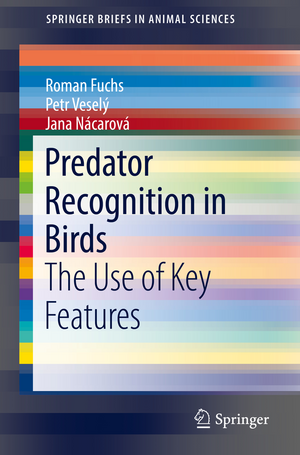Predator Recognition in Birds: The Use of Key Features: SpringerBriefs in Animal Sciences
Autor Roman Fuchs, Petr Veselý, Jana Nácarováen Limba Engleză Paperback – 4 apr 2019
Din seria SpringerBriefs in Animal Sciences
-
 Preț: 372.35 lei
Preț: 372.35 lei -
 Preț: 380.63 lei
Preț: 380.63 lei -
 Preț: 381.00 lei
Preț: 381.00 lei -
 Preț: 377.18 lei
Preț: 377.18 lei -
 Preț: 382.18 lei
Preț: 382.18 lei - 5%
 Preț: 359.05 lei
Preț: 359.05 lei -
 Preț: 377.95 lei
Preț: 377.95 lei -
 Preț: 446.08 lei
Preț: 446.08 lei
Preț: 378.54 lei
Nou
Puncte Express: 568
Preț estimativ în valută:
72.44€ • 75.35$ • 59.81£
72.44€ • 75.35$ • 59.81£
Carte tipărită la comandă
Livrare economică 14-28 aprilie
Preluare comenzi: 021 569.72.76
Specificații
ISBN-13: 9783030124021
ISBN-10: 3030124029
Pagini: 90
Ilustrații: X, 117 p. 8 illus.
Dimensiuni: 155 x 235 mm
Greutate: 0.19 kg
Ediția:1st ed. 2019
Editura: Springer International Publishing
Colecția Springer
Seria SpringerBriefs in Animal Sciences
Locul publicării:Cham, Switzerland
ISBN-10: 3030124029
Pagini: 90
Ilustrații: X, 117 p. 8 illus.
Dimensiuni: 155 x 235 mm
Greutate: 0.19 kg
Ediția:1st ed. 2019
Editura: Springer International Publishing
Colecția Springer
Seria SpringerBriefs in Animal Sciences
Locul publicării:Cham, Switzerland
Cuprins
1 What do we know about predator recognition by untrained birds?.- 1.1 The study of predator recognition (How to make birds respond in etho-ecological experiments - to show that they recognized the predator – nest defense, feeder experiments, laboratory experiments…).- 1.2 Evidence for predator recognition ability (What predator categories birds recognize – predator vs. non-predator, aerial vs. terrestrial predators, individual predator species…).- 1.3 Tools used for predator recognition (What cues bird use for predator recognition – sign stimuli, coloration, size…).- 2 What can the recognition experiments with trained pigeons tell?.- 2.1 Category discrimination and concepts formation (How do birds form categories of predators – memorizing vs. generalization vs. conceptualization…).- 2.2 Object recognition (What cues birds use for predator recognition – particulate feature theory vs. recognition by components, local vs. global features…).- 2.3 Other cognitive processes (Are we able toreveal other cognitive processes in predator recognition by birds – amodal completion, priming…).
Notă biografică
Dr. Roman Fuchs
Department of Zoology
Faculty of Science
University of South Bohemia
Branišovská 1760 37005
České Budějovice
Czech Republic
Department of Zoology
Faculty of Science
University of South BohemiaBranišovská 1760 37005
České Budějovice
Czech Republic
Dr. Jana Nácarová
Department of Zoology
Faculty of Science
University of South Bohemia
Branišovská 1760 37005
České Budějovice
Czech Republic
Caracteristici
Provides a concise overview on avian predator recognition Discusses both ethological and cognitive approaches Describes in detail the use of key factors to recognize predators
